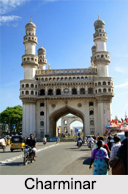 Charminar is an early medieval monument of Hyderabad, Telangana. This old monument was erected in the year 1591.This medieval monument is an example of Muslim art and architecture and the Nizami architecture that was developed in the latter half of medieval era. It is now the global icon of South India. Charminar is one of the most important tourist attractions of Hyderabad. Many local festivals are celebrated here, like Ramzaan.
Charminar is an early medieval monument of Hyderabad, Telangana. This old monument was erected in the year 1591.This medieval monument is an example of Muslim art and architecture and the Nizami architecture that was developed in the latter half of medieval era. It is now the global icon of South India. Charminar is one of the most important tourist attractions of Hyderabad. Many local festivals are celebrated here, like Ramzaan.
Charminar is situated on the east bank of Musi River; to the west lies the Laad Bazaar, and to the southwest lies the richly ornamented granite Makkah Masjid. It is listed as an archaeological and architectural treasure on the official "List of Monuments", which has been prepared by the Archaeological Survey of India.
History of Charminar
There are several views on the construction of Charminar. But mostly it is said that Muhammad Quli Qutb Shah, the fifth ruler of the Qutb Shahi dynasty built the Charminar in the year 1591 after shifting his capital from Golkonda to Hyderabad. Charminar was built at the center of the city to commemorate the eradication of Cholera. This disease was spreading widely at that time.
Architecture of Charminar
The architecture of Charminar is a real grandeur of the Qutub Shahi era. It is a magnificent square edifice of granite, which was built upon four grand arches facing all the four directions. These arches support two floors of rooms and gallery of archways. At each corner of the square structure, there is a minaret rising to a height of 24 meters, making the building nearly 54 meters tall. It is these four (char) minarets (minar) that give the building, its name `Charminar`. Each minar stands on a lotus-leaf base; it is a special recurrent motif in Qutub Shahi buildings. The first floor was used as a Madrasa (college) during the Qutub Shahi period. The second floor has a mosque on the western side, the dome of which is visible from the road, if one stands some distance away.
Further down, a road to the left leads to the Khilawat Complex (Chowmahalla Palace). A spectacular view of the city may be found from the roof of the Charminar, although, due to severe overcrowding of the minarets, only visitors with special permission from the Archaeological Survey of India, Hyderabad Circle are allowed to go to the top of the minarets. The clocks above each of the four archways were added in 1889. As old as the city itself, the four imposing towers of this edifice stand in the heart of the old city as a hallmark of the Qutub Shahi era. The grounds are now being used for the development of a large commercial complex.
Charminar Constituency
The area, which is surrounding this edifice, is also known as Charminar. This area mainly falls under the Charminar Constituency. Makkah Masjid, Bazaars, Char Kaman and Gulzar Houz come under this area.
Charminar on UNESCO-Tentative List
Charminar, the Golconda Fort and the Qutb Shahi Tombs have been included in the "tentative list" of UNESCO World Heritage Site. The Monument was submitted by the Permanent Delegation of India to UNESCO on September 10, 2010.
Visiting Information to Charminar
Charminar is just 5 km away from Hyderabad Bus Station. Regular buses are operated by APSRTC (Andhra Pradesh State Road Transport Corporation) from every part of the city. One can also reach this site by hiring an auto-rickshaw or a cab from anywhere in the city.



















